含柑橘纤维和树胶的牛奶冰淇淋的品质特性
IF 2.6
3区 农林科学
Q1 AGRICULTURE, MULTIDISCIPLINARY
Agroecology and Sustainable Food Systems
Pub Date : 2023-07-13
DOI:10.21323/2618-9771-2023-6-2-261-268
引用次数: 0
摘要
目前,至少有4种食品添加剂——乳化剂和水胶体——用于冰淇淋生产,以稳定其结构。然而,添加这些物质会减少健康生活习惯者对该产品的需求。这项研究的目的是确定使用柑橘纤维及其成分与瓜尔胶和黄原胶一起稳定牛奶冰淇淋结构的可能性。用明胶和复合稳定剂(乳化剂)作为对照样品。结果表明,柑橘纤维添加量为0.6%时,产品苦味明显,混合液的动态粘度不能满足要求,气相不稳定,形成较大的冰晶。膳食纤维与树胶的组合对这些品质特性有积极的影响。在添加纤维和黄原胶的情况下,样品的冰晶分散度最高(平均粒径为36 ~ 39 μm),动态粘度与添加复合稳定乳化剂的样品的质量特性相当。添加柑橘纤维和瓜尔胶的样品在耐热性方面优于只添加纤维的样品,也优于添加普通纤维和瓜尔胶的样品。保温60 min后,熔体质量分数为7%,分别比不加胶和加黄原胶的样品低2.8倍和2倍。“硬度”参数与“热稳定性”参数之间存在相关性:最硬的样品具有最高的抗熔化性。在此基础上,确定了柑橘纤维与瓜尔胶或黄原胶复合使用在有限食品添加剂条件下生产冰淇淋的便利性。同时,在产品储存过程中,必须考虑结构元件的状态,并使用有助于保持冰淇淋部分形状的包装。本文章由计算机程序翻译,如有差异,请以英文原文为准。
Quality characteristics of milk ice cream with citrus fibers and gum
Currently at least 4 food additives — emulsifiers and hydrocolloids — are used for ice cream production to stabilize its structure. However adding these substances reduces the demand for this product among healthy lifestyle adepts. The aim of the research was to define the possibility of using citrus fibers and their compositions together with guar and xanthan gums to stabilize the milk ice cream structure. Samples with gelatin and a complex stabilizer (emulsifier) were used as control samples. It was established that adding of citrus fibers in amount of 0.6% makes the product bitter, does not provide the required level of dynamic viscosity of the mixture, it forms an unstable air phase and large ice crystals. The combination of dietary fibers with gums had a positive effect on these quality characteristics. The highest dispersion of ice crystals (average size accounted for 36–39 μm) and dynamic viscosity of the mixture, comparable with the quality characteristics of the sample with a complex stabilizeremulsifier, was achieved in the sample with added fibers and xanthan gum. The sample with dietary citrus fiber and guar gum showed better characteristics in terms of heat resistance in comparison with the samples with fiber only, as well as samples with plain fiber and guar gum. After 60 min of thermostating, the mass fraction of melt was equal to 7%, which is 2.8 and 2 times less than in samples without gums and with xanthan gum. The correlation was found between the parameter “hardness” and the parameter “thermal stability”: the hardest samples showed the highest resistance to melting. Based on the results of the research, the expediency of using combinations of citrus fibers and guar gum or xanthan gum in the production of ice cream with a limited number of food additives was established. Meanwhile it is necessary to take into account the state of structural elements during the product storage, and using the packaging that helps preserve the shape of the ice cream portion.
求助全文
通过发布文献求助,成功后即可免费获取论文全文。
去求助
来源期刊

Agroecology and Sustainable Food Systems
AGRICULTURE, MULTIDISCIPLINARY-GREEN & SUSTAINABLE SCIENCE & TECHNOLOGY
CiteScore
4.80
自引率
7.70%
发文量
73
期刊介绍:
Agroecology and Sustainable Food Systems is devoted to the rapidly emerging fields of agroecology and food system sustainability. By linking scientific inquiry and productive practice with transformative social action, agroecology provides a foundation for developing the alternative food systems of the future. The journal focuses on the changes that need to occur in the design and management of our food systems in order to balance natural resource use and environmental protection with the needs of production, economic viability, food security, and the social well-being of all people.
Agroecology and Sustainable Food Systems examines our current food systems from production to consumption, and the urgent need to transition to long-term sustainability. The journal promotes the study and application of agroecology for developing alternatives to the complex problems of resource depletion, environmental degradation, a narrowing of agrobiodiversity, continued world hunger, consolidation and industrialization of the food system, climate change, and the loss of farm land. The journal uses a food systems approach, and seeks experiences in agroecology that are on-farm, participatory, change-oriented, and backed by broad-based methodologies of sustainability analysis and evaluation.
 求助内容:
求助内容: 应助结果提醒方式:
应助结果提醒方式:


